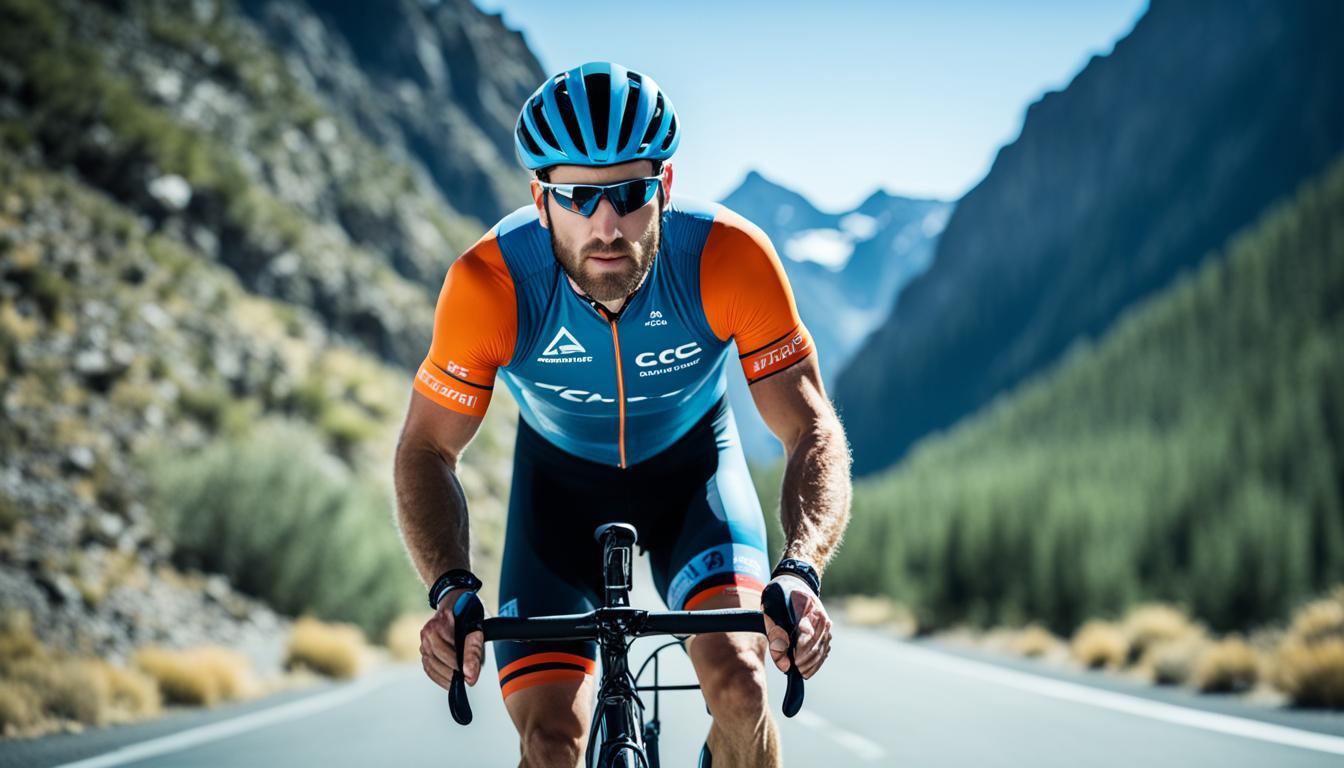Embarking on your triathlon journey is the first step to unlocking a world filled with possibilities. This triathlon beginner’s guide will help you understand how triathlon training plans become your blueprint for success. You’ll learn how to dominate swimming techniques, power through bike training, and swiftly transition from biking to running.
Your dedication to this challenge will influence your selection of triathlon gear. Careful consideration of race day tips will boost your performance. And don’t forget the integral role of nutrition and hydration as you train! Mix in cross-training for robust conditioning, all while prioritizing injury prevention, and you’ll build a strong foundation for success.
The triathlon community is filled with enthusiastic and seasoned athletes ready to welcome you with open arms, offering encouragement, race advice, and camaraderie. Local races provide an incredible opportunity to dip your toes into the exciting world of triathlon. So gear up, stay motivated, and relish the journey to that glorious finish line – you’re about to become a triathlete!
Key Takeaways From This Triathlon Beginner’s Guide
As you start your triathlon journey, remember these essential points:
- Structured Training: A well-designed triathlon training plan is essential for success.
- Refine Your Technique: Focus on proper swimming and biking form for speed and efficiency.
- Master Transitions: Practice switching disciplines to improve race times.
- Essential Gear: Invest in quality triathlon gear for comfort and performance.
- Race Day Success: Proven race day tips will boost your confidence.
- Fuel Your Training: Emphasize nutrition and hydration for peak performance and recovery.
- Stay Healthy: Incorporate cross-training and injury prevention techniques.
- Join the Community: Connect with the triathlon community for support and motivation.
Embarking on Your Triathlon Journey: A Triathlon Beginner’s Guide
The triathlon community welcomes athletes of all levels and backgrounds. Whether you’re completely new to swimming, have a love for long bike rides, or have never run competitively, there’s room for you here. This triathlon beginner’s guide will help you understand the sport, the community, and the steps to prepare for your first race.
Committing to your first triathlon means more than just physical training; it’s a journey of self-discovery. Your motivation might stem from a desire for life-changing transformation, whether it’s weight loss, building confidence, or overcoming personal obstacles. Experienced coaches like those at C26 Triathlon have seen countless stories of triumph. They emphasize the importance of consistency and patience – these will be your most powerful allies in training.
Understanding the different triathlon distances is key to starting your journey. From shorter sprint triathlons to the legendary Ironman, each distance offers its unique challenges and rewards. Setting realistic goals is essential for a positive first experience!
Here are some tips for new triathletes:
- Start with a Sprint: Choose a sprint triathlon to give yourself a taste of the sport.
- Consistency is Key: Prioritize regular training over infrequent bursts.
- Join a Training Group: The support of a group is invaluable.
- Be Patient: It takes time to build fitness. Don’t expect instant results.
Remember, everyone starts somewhere. The most accomplished triathletes were once in your shoes. Through consistent, patient effort, they achieved success and found deep fulfillment in the sport. Your journey starts now – the only pace that matters is the one that keeps you moving forward!
Understanding Triathlon Distances : A Triathlon Beginner’s Guide
Embarking on your triathlon training journey presents a variety of race distances that cater to different fitness levels and ambitions. From the quick-paced sprint triathlon to the legendary endurance challenge of an Ironman, understanding the demands of each distance is pivotal to choosing a race that aligns with your goals and readiness. Let’s break them down in this triathlon beginner’s guide
Comparing Sprint, Olympic, Half-Ironman, and Ironman Triathlons
| Triathlon Distance | Swim | Bike | Run | Total Distance |
|---|---|---|---|---|
| Sprint | 0.5 mi (750 m) | 12.4 mi (20 km) | 3.1 mi (5 km) | Approx. 16 mi (25.75 km) |
| Olympic | 0.93 mi (1.5 km) | 24.8 mi (40 km) | 6.2 mi (10 km) | Approx. 32 mi (51.5 km) |
| Half-Ironman | 1.2 mi (1.9 km) | 56 mi (90 km) | 13.1 mi (21 km) | Approx. 70.3 mi (113 km) |
| Ironman | 2.4 mi (3.8 km) | 112 mi (180 km) | 26.2 mi (42 km) | Approx. 140.6 mi (226 km) |
Choosing the Right Distance for Your Fitness Level
When deciding which distance to tackle, coaches like Lacy Healey often recommend starting with a sprint triathlon to introduce you to the triathlon experience. If you have a strong background in one of the three disciplines, you might consider stepping up to an Olympic triathlon. Kelsey Abbott encourages athletes to select a distance that matches their current fitness and comfort level so you can build confidence as you progress.
Consider these factors when choosing your race distance:
- Your Experience: Assess your individual experience in swimming, biking, and running.
- Training Time: How much time can you realistically dedicate to preparation?
- Long-term Goals: Do you want to progress through distances or aim high from the start?
As you gain more experience, the allure of the half-Ironman and Ironman distances may grow. These distances require even greater dedication to training and a deep passion for pushing your limits. No matter the distance, each triathlon is a journey of discovery, resilience, and ultimately, a huge accomplishment that you’ll forever cherish.
 Creating a Triathlon Training Plan That Works for You
Creating a Triathlon Training Plan That Works for You
A carefully crafted triathlon training plan is essential for success. Understanding the fundamentals of swimming techniques, bike training, and running workouts is important, too. Professional coaches like Jennifer Hutchison and Aleks Todorova emphasize the importance of customized plans that use progressive training periodization to help you gradually advance in each discipline. This will build your endurance while minimizing injury risk and burnout.
Additionally, consider incorporating cross-training into your routine to build overall strength and resilience. A diverse training schedule will not only keep you engaged but will also prepare your body and mind for the demands of race day.
Here’s where to find the right triathlon training plan:
- Reputable Sources: Look for plans from sources like Endurance Nation, which offer plans for various abilities and goals.
- Technology Platforms: TrainingPeaks provides customized and low-cost training solutions.
- Free Online Plans: Many online resources offer free plans as starting points.
By aligning yourself with experienced coaches and utilizing dynamic training platforms, you can create a triathlon training plan that fits seamlessly into your lifestyle and helps you achieve your personal best. Remember, the journey of triathlon is as rewarding as crossing the finish line. Embrace each stroke, pedal, and step along the way!
The Essential Triathlon Gear Checklist : A Triathlon Beginner’s Guide
Every step of your triathlon training brings you closer to your goals, and having the right gear can make a significant difference on race day. Let’s delve into the essentials for each discipline.
Swim Essentials: From Goggles to Wetsuits
Your swim gear is your first ally in the race. Key components include:
- Goggles: Ensure clear vision.
- Swim Cap: Reduces drag.
- Triathlon Wetsuit: Provides buoyancy and warmth in open water swims.
Cycling Gear: Bikes, Helmets, and Tools
Safety and efficiency define the cycling stage. Your key equipment includes:
- Road Bike: A sturdy and aerodynamic foundation for speed.
- Bike Helmet: Proper protection is non-negotiable.
- Flat Repair Kit: Be prepared for minor mechanical issues.
Run Gear: Choosing the Right Shoes and Apparel
The final leg of the race relies on endurance. Your gear can give you an edge:
- Running Shoes: A professional gait analysis can lead you to the perfect shoe.
- Technical Fabric Clothing: Choose apparel that wicks away moisture and prevents chafing.
Remember, this gear checklist is a foundation. Each triathlete’s needs may vary, so personalize your gear choices to suit your training, body, and goals. Happy racing!
| Discipline | Essential Gear | Additional Recommendations |
|---|---|---|
| Swim | Goggles, Swim Cap, Triathlon Wetsuit | Anti-fog spray, Earplugs |
| Bike | Bike Helmet, Flat Repair Kit, Water Bottles | Cycling Gloves, Sunglasses |
| Run | Running Shoes, Technical Fabric Clothing | Heart Rate Monitor, Sports Watch |


 Creating a Triathlon Training Plan That Works for You
Creating a Triathlon Training Plan That Works for You





